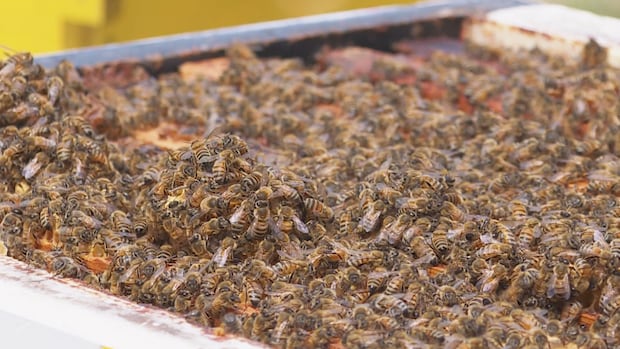2025 shaping up to be a good year for P.E.I. honey producers, with fewer bees dying off
Winter die-off rate on the Island well below the national average, report suggests

Honey bees on Prince Edward Island have been dying off at lower rates this year compared to the national average, according numbers from the Canadian Association of Professional Apiculturists.
P.E.I.'s 23 per cent winter loss rate contrasts with that of New Brunswick, which experienced a higher rate at 44.7 per cent. The national average was around 36 per cent.
While it's hard to pinpoint an exact reason for the lower numbers on the Island, there are some theories.
Troy Frasier, president of the P.E.I. Beekeepers Association, said the final version of the association's report will show how the losses occurred.

"In past years, you know, it's due to starvation, poor queens, varroa mite, and climate, weather change," he said.
"It also comes down to... the beekeeper reporting as to what they saw in their colony losses as to what could have been the cause... for those mortality rates."
Frasier said conditions last winter were good for bees, and that there has been more education for keepers on how to deal with threats to their colonies like varroa mites — a parasite that attacks and feeds on honey bees.
An infestation of the mites, which normally occurs in late fall or early spring, can lead to the death of an entire colony.
Not the cold killing off bees
Fraiser said it's surprising how well bees can survive over the winter months, and that it's not the cold that kills them.
"It's more of the March and April months where we have these big swings in weather temperatures," he said.
"They don't hibernate, they go semi-dormant. They're in a cluster, like the size of a basketball, soccer ball in the hive."
This allows the bees to conserve heat within the hive, as long as they have the proper resources to consume.
"When we get to March and April, we see these swings in temperature, then you're going to see that cluster break up a tiny bit as the temperature increases and the ambient temperature inside the hive increases," he said.
"As the temperature drops rapidly, those small pockets in the cluster can't get back and they start dying off."
What made the difference?
The difference between P.E.I. and New Brunswick's die-off rates could come down to geography.
"They may get snow sooner, they may get temperature swings sooner," Frasier said.
"We have to do certain things at certain times of the year, and if you're not on top of that, if you're not adapted to that particular geography, things are going to be different for you."
Fraiser said P.E.I. beekeepers administer treatments each spring to protect their colonies from the varroa mite.
"Some beekeepers haven't done that in the past.... That could be one aspect to why things are getting a little better for us," he said. "Whenever we harvest in September, early October, we do our fall treatment to set them up for winter."
Keepers generally avoid the treatment during the summer months because that's when the hives begin producing honey.
It all means that this year is shaping up to be a good one for beekeepers and honey production.
"Stronger hives coming out of winter will mean better pollination of fruit crops on the Island, also more honey production," he said.
"I've harvested earlier now than I have any other year in the short timeframe I've been keeping bees, and I'm setting up for a pretty decent year."
With files from Jackie Sharkey


